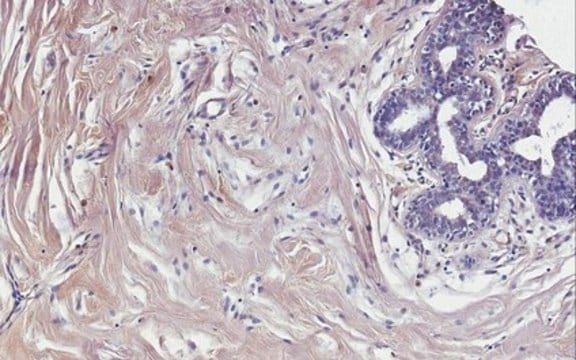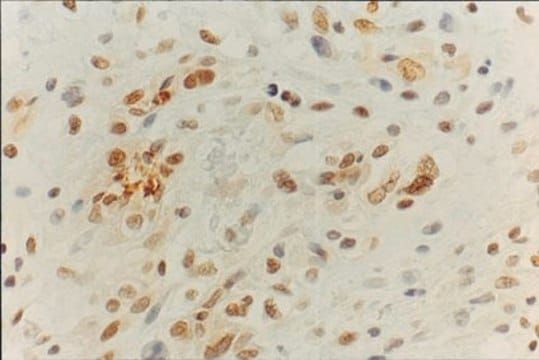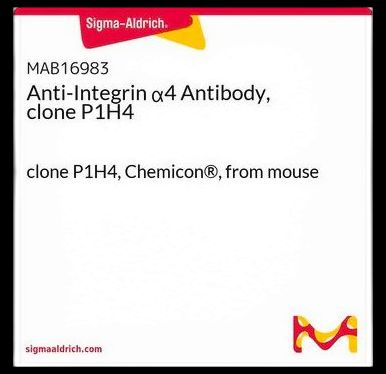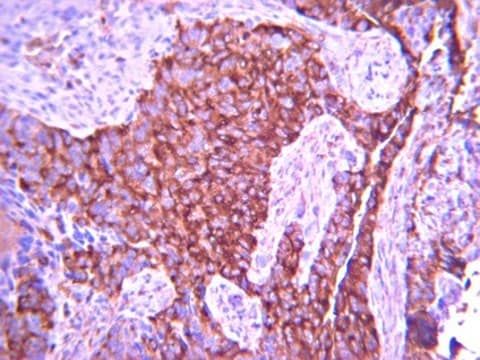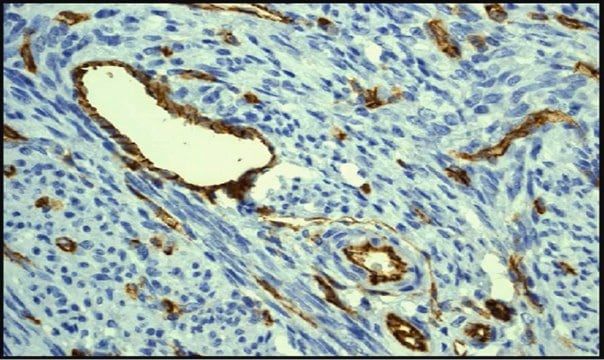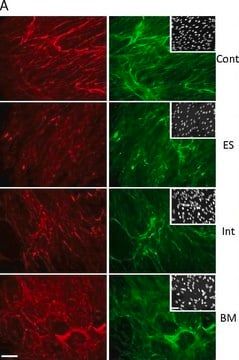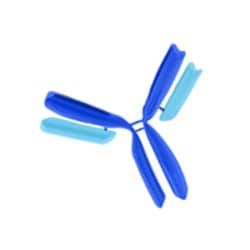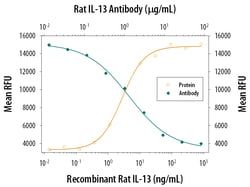MAB1944
Anti-Collagen Type VI Antibody, clone 3C4
ascites fluid, clone 3C4, Chemicon®
Manufacturer: Sigma Aldrich
Synonym(S): Collagen alpha-3(VI) chain, Collagen VI alpha-3 polypeptide
Select a Size
| Pack Size | SKU | Availability | Price |
|---|---|---|---|
| 100 μL | MAB1944-100-μL | In Stock | ₹ 49,099.99 |
MAB1944 - 100 μL
In Stock
Quantity
1
Base Price: ₹ 49,099.99
GST (18%): ₹ 8,837.998
Total Price: ₹ 57,937.988
biological source
mouse
Quality Level
100
antibody form
ascites fluid
antibody product type
primary antibodies
clone
3C4, monoclonal
species reactivity
human
manufacturer/tradename
Chemicon®
technique(s)
electron microscopy: suitableflow cytometry: suitableimmunocytochemistry: suitableimmunohistochemistry: suitable (paraffin)immunoprecipitation (IP): suitable
isotype
IgG1κ
NCBI accession no.
NP_004360
Description
- General description: Collagen alpha-3(VI) chain (UniProt P12111; also known as Collagen VI alpha-3 polypeptide) is encoded by the COL6A3 gene (Gene ID 1293) in human. Type VI collagen is an extracellular matrix (ECM) component present in virtually all connective tissues, including cartilage, bone, tendon, muscles and cornea, where it forms microfibrils in close association with basement membranes. In addition to anchoring the basement membrane to the pericellular matrix in muscle, research also indicates a role for collagen VI in cell signaling and cell migration. The basic structural unit of collagen VI is a heterotrimer composed of the alpha-1(VI), alpha-2(VI), and alpha-3(VI) chains (encoded by the COL6A1, COL6A2, and COL6A3 genes, respectively). The α1(VI) and α2(VI) chains are similar in size and domain structure, they contain a 335- or 336-amino acid triple helix region that is characteristic of all collagens. Flanking the triple helix are domains homologous to the A-type domains found in von Willebrand factor (VWA domains). α1(VI) and α2(VI) contain one VWA domain N-terminal to the triple helix (N1) and two VWA domains C-terminal of the helix (C1 and C2). The α3(VI) chain, on the other hand, is much larger with 10 N-terminal (N1–N10) and two C-terminal VWA domains (C1 and C2), and several other types of identifiable domains in the C terminal region (C3–C5). Mutations in the COL6A1, COL6A2, and COL6A3 genes are known causes of Ullrich congenital muscular dystrophy (UCMD) and Bethlem myopathy (BM). Three additional type VI collagen chains have been reported in 2008 (α4(VI), α5(VI) and α6(VI) chains encoded by COL6A4, COL6A5, and COL6A6, respectively).
- Specificity: Clone 3C4 targets the non-helical region of alpha-3(VI) chain.
- Immunogen: Epitope: Non-helical region.
- Application: Flow Cytometry Analysis: A representative lot detected intracellular type VI collagen retention by flow cytometry using permeabilized and non-permeabilized fibroblasts isolated from both healthy individuals, as well as Ullrich congenital muscular dystrophy (UCMD) and Bethlem myopathy (BM) patients (Kim, J., et al. (2012). Neuromuscul. Disord. 22(2):139-148).Immunocytochemistry Analysis: Representative lots detected extracellular type VI collagen immunoreactivity in cultured fibroblasts isolated from Ullrich congenital muscular dystrophy (UCMD) and Bethlem myopathy (BM) patients by fluorescent immunocytochemistry (Kim, J., et al. (2012). Neuromuscul. Disord. 22(2):139-148; Allamand, V., et al. (2011). Skelet Muscle. 1:30; Briñas, L., et al. (2010). Ann. Neurol. 68(4):511-520; Jimenez-Mallebrera, C., et al. (2006). Neuromuscul. Disord. 16(9-10):571-582; Tétreault, M., et al. (2004). Brain. 129(Pt 8):2077-2084; Zhang, R.Z., et al. (2002). J. Biol. Chem. 277(46):43557-43564).Immunocytochemistry Analysis: A representative lot detected exogenously expressed wild-type α3(VI) chain, as well as α3(VI) chain with G49A or G301V mutation in SaOS-2 transfectants by fluorescent immunocytochemistry (Lamandé, S.R., et al. (2002). J. Biol. Chem. 277(3):1949-1956).Immunocytochemistry Analysis: Representative lots immunostained extracellular type VI collagen fibrils in human MG63 osteosarcoma cells and primary foreskin fibroblasts cultures (Bruns, R.R., et al. (1986). J. Cell Biol. 103(2):393-404; Engvall, E., et al. (1986). J. Cell Biol. 102(3):703-710).Immunohistochemistry Analysis: A representative lot detected human type VI collagen immunoreactivity in frozen muscle tissue sections from mice grafted with human synovial stem cells (hSSCs) by fluorescent immunohistochemistry (Meng, J., et al. (2010). Neuromuscul. Disord. 20(1):6-15).Immunohistochemistry Analysis: Representative lots detected type VI collagen immunoreactivity in muscle and skin samples from congenital muscular dystrophy (CMD) and Ullrich congenital muscular dystrophy (UCMD) patients by fluorescent immunohistochemistry using frozen tissue sections (Peat, R.A., et al. (2008). Neurology. 71(5):312-321; Jimenez-Mallebrera, C., et al. (2006). Neuromuscul. Disord. 16(9-10):571-582).Immunoprecipitation Analysis: A representative lot co-immunoprecipitated type VI collagen α1(VI) and α2(VI) chains with wild-type α3(VI) chain, as well as α3(VI) chain with G16S or G49A mutation. Impaired α1(VI) and α2(VI) co-IP was observed with α3(VI) G301V mutant (Lamandé, S.R., et al. (2002). J. Biol. Chem. 277(3):1949-1956).Immunoprecipitation Analysis: A representative lot immunoprecipitated type VI collagen alpha chains from Triton X-100 extracts of MRC-5 human lung fibroblasts (Engvall, E., et al. (1986). J. Cell Biol. 102(3):703-710).Electron Microscopy Analysis: A representative lot detected reduced extracellular type VI collagen immunoreactivity in cultured fibroblasts isolated from an Ullrich congenital muscular dystrophy (UCMD) patient (Zhang, R.Z., et al. (2002). J. Biol. Chem. 277(46):43557-43564).Electron Microscopy Analysis: A representative lot immunostained extracellular filaments and fibrils by binding to the band (non-helical) region of the type VI collagen fibrils using cultured human foreskin fibroblasts (Bruns, R.R., et al. (1986). J. Cell Biol. 103(2):393-404).Dot Blot Analysis: A representative lot detected exogenously expressed wild-type α3(VI) chain, as well as α3(VI) chain with G49A or G301V mutation in the medium of cultured SaOS-2 transfectants (Lamandé, S.R., et al. (2002). J. Biol. Chem. 277(3):1949-1956).
- Target description: 343.7/321.4/113.2/278.2/134.7 kDa (isoform 1/2/3/4/5 pro-form) and 340.8/318.5/110.4/275.3/131.8 kDa (isoform 1/2/3/4/5 mature form) calculated
- Physical form: Liquid
- Storage and Stability: Maintain frozen at -20°C. Avoid repeated freeze/thaw cycles.
- Legal Information: CHEMICON is a registered trademark of Merck KGaA, Darmstadt, Germany
- Disclaimer: Unless otherwise stated in our catalog or other company documentation accompanying the product(s), our products are intended for research use only and are not to be used for any other purpose, which includes but is not limited to, unauthorized commercial uses, in vitro diagnostic uses, ex vivo or in vivo therapeutic uses or any type of consumption or application to humans or animals.
SAFETY INFORMATION
WGK
WGK 1
Flash Point(F)
Not applicable
Flash Point(C)
Not applicable
Compare Similar Items
Show Difference
biological source: mouse
Quality Level: 100
antibody form: ascites fluid
antibody product type: primary antibodies
clone: 3C4, monoclonal
species reactivity: human
manufacturer/tradename: Chemicon®
technique(s): electron microscopy: suitableflow cytometry: suitableimmunocytochemistry: suitableimmunohistochemistry: suitable (paraffin)immunoprecipitation (IP): suitable
isotype: IgG1κ
NCBI accession no.: NP_004360
biological source:
mouse
Quality Level:
100
antibody form:
ascites fluid
antibody product type:
primary antibodies
clone:
3C4, monoclonal
species reactivity:
human
manufacturer/tradename:
Chemicon®
technique(s):
electron microscopy: suitableflow cytometry: suitableimmunocytochemistry: suitableimmunohistochemistry: suitable (paraffin)immunoprecipitation (IP): suitable
isotype:
IgG1κ
NCBI accession no.:
NP_004360
biological source: mouse
Quality Level: 100
antibody form: culture supernatant
antibody product type: primary antibodies
clone: 3C4, monoclonal
species reactivity: human
manufacturer/tradename: __
technique(s): electron microscopy: suitableflow cytometry: suitableimmunocytochemistry: suitableimmunohistochemistry: suitable (paraffin)immunoprecipitation (IP): suitable
isotype: IgG1κ
NCBI accession no.: NP_004360
biological source:
mouse
Quality Level:
100
antibody form:
culture supernatant
antibody product type:
primary antibodies
clone:
3C4, monoclonal
species reactivity:
human
manufacturer/tradename:
__
technique(s):
electron microscopy: suitableflow cytometry: suitableimmunocytochemistry: suitableimmunohistochemistry: suitable (paraffin)immunoprecipitation (IP): suitable
isotype:
IgG1κ
NCBI accession no.:
NP_004360
